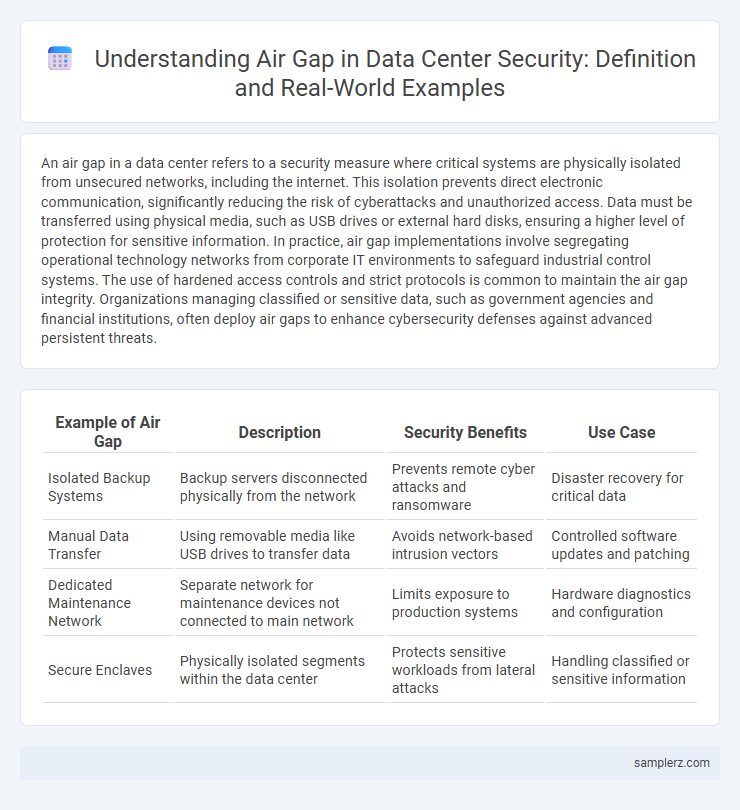An air gap in a data center refers to a security measure where critical systems are physically isolated from unsecured networks, including the internet. This isolation prevents direct electronic communication, significantly reducing the risk of cyberattacks and unauthorized access. Data must be transferred using physical media, such as USB drives or external hard disks, ensuring a higher level of protection for sensitive information. In practice, air gap implementations involve segregating operational technology networks from corporate IT environments to safeguard industrial control systems. The use of hardened access controls and strict protocols is common to maintain the air gap integrity. Organizations managing classified or sensitive data, such as government agencies and financial institutions, often deploy air gaps to enhance cybersecurity defenses against advanced persistent threats.
Table of Comparison
| Example of Air Gap | Description | Security Benefits | Use Case |
|---|---|---|---|
| Isolated Backup Systems | Backup servers disconnected physically from the network | Prevents remote cyber attacks and ransomware | Disaster recovery for critical data |
| Manual Data Transfer | Using removable media like USB drives to transfer data | Avoids network-based intrusion vectors | Controlled software updates and patching |
| Dedicated Maintenance Network | Separate network for maintenance devices not connected to main network | Limits exposure to production systems | Hardware diagnostics and configuration |
| Secure Enclaves | Physically isolated segments within the data center | Protects sensitive workloads from lateral attacks | Handling classified or sensitive information |
Introduction to Air Gapping in Data Centers
Air gapping in data centers involves physically isolating critical systems from unsecured networks to prevent unauthorized access and cyber threats. This security measure ensures sensitive data remains protected by eliminating direct connections to the internet or other external networks. For example, a financial institution may use air-gapped servers to handle transaction processing, significantly reducing the risk of data breaches.
Key Benefits of Implementing Air Gaps
Air gaps in data centers provide robust protection by physically isolating critical systems from external networks, significantly reducing the risk of cyberattacks such as ransomware or data breaches. This physical separation ensures sensitive data remains secure even if connected networks are compromised, enhancing overall data integrity and confidentiality. Additionally, air gaps enable compliance with stringent regulatory requirements by preventing unauthorized access and minimizing attack surfaces.
Physical Air Gap Example: Isolated Server Racks
Isolated server racks within a data center exemplify a physical air gap by ensuring critical systems operate without any direct network or data connections to other infrastructure. These server racks are physically separated by secured enclosures, preventing unauthorized access and electromagnetic interference, thereby mitigating cyberattack risks. This physical segregation enhances security by blocking any digital communication channels, protecting sensitive data from remote intrusions.
Logical Air Gap Example: Segmented Network Environments
Logical air gap in data centers involves segmented network environments where critical systems operate on isolated VLANs with strict firewall rules preventing direct communication with less secure zones. This segmentation limits attack surfaces by enforcing access control lists (ACLs) and monitoring inter-segment traffic through intrusion detection systems (IDS). Such configurations enhance data protection by ensuring sensitive operations remain logically separated despite physical network interconnections.
Offline Backup Solutions in Data Centers
Offline backup solutions in data centers leverage air gap security by physically isolating backup media from the network to prevent cyber threats such as ransomware or malware infections. These backups are stored on external devices like tapes or hard drives that are disconnected from all systems until data restoration is necessary, ensuring data integrity and resilience. Employing this approach minimizes the risk of unauthorized access or data corruption, safeguarding critical information assets in high-security environments.
Use of Removable Media for Data Transfers
Air-gapped data centers enhance security by physically isolating sensitive systems from external networks, preventing direct cyberattacks. In these environments, removable media such as encrypted USB drives or optical discs serve as controlled conduits for data transfer, ensuring that critical information moves without exposing the network to internet-based threats. Strict protocols govern the use of removable media to mitigate risks of malware introduction and unauthorized access within the secure facility.
Data Diode Deployment for One-Way Communication
Data diode deployment in data centers ensures one-way communication by physically enforcing unidirectional data flow, preventing cyber threats from entering secure networks. This air gap technology is critical for protecting highly sensitive systems, such as SCADA networks and classified government information, by allowing data to exit without enabling inbound connections. Implementing data diodes reduces the attack surface and enhances the integrity of critical infrastructure within isolated environments.
Air Gapped Disaster Recovery Sites
Air gapped disaster recovery sites are physically isolated data centers that maintain no direct network connections to primary facilities, ensuring protection against cyberattacks and ransomware. These sites store critical backups and system images offline, enabling secure, tamper-proof recovery during catastrophic events. Implementing air gap technology in disaster recovery enhances data integrity, minimizes recovery time objectives (RTO), and strengthens overall cybersecurity posture.
Manual Data Migration Processes
Manual data migration processes in air-gapped data centers involve physically transferring data using removable media like external hard drives or USB flash drives, ensuring no direct network connection exists between secure and non-secure environments. This method significantly reduces the risk of cyberattacks by isolating sensitive systems from external threats, enforcing strict protocols for media handling, encryption, and access control. Regular audits and comprehensive documentation of data transfers enhance the integrity and security of manual migration within air-gapped infrastructures.
Case Studies: Real-World Air Gap Implementations
In a high-security government data center, strict air gap protocols isolate sensitive networks, preventing any direct electronic connection to external systems and mitigating cyber threats. Another case study involves a financial institution using air gap techniques to safeguard critical transaction servers, relying on manual data transfers via secure, removable media to maintain data integrity. These implementations demonstrate how air gaps effectively reduce attack surfaces and enhance data protection in environments with stringent security requirements.

example of air gap in data center Infographic
 samplerz.com
samplerz.com